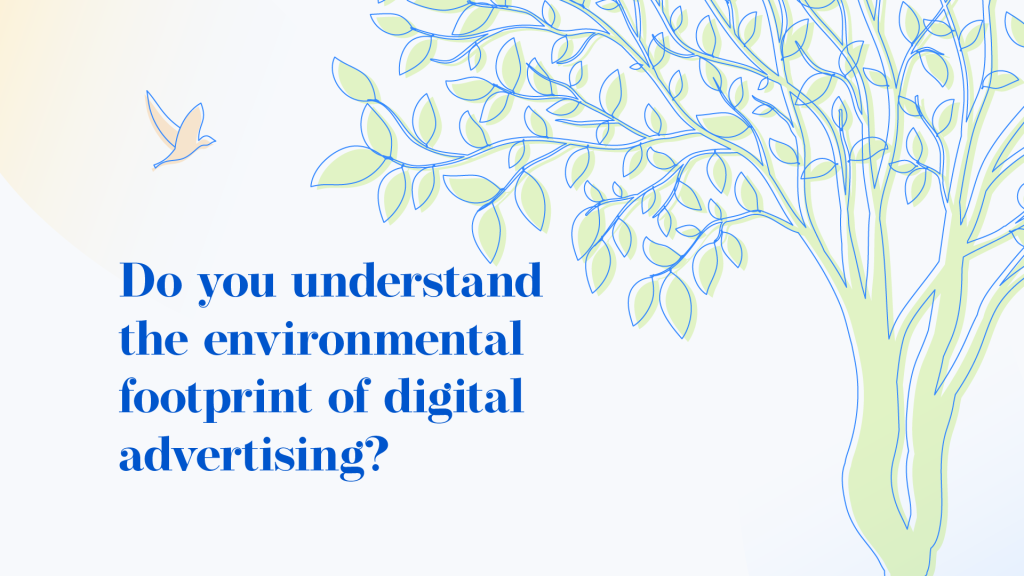Loading a single ad consumes about as much energy as washing clothes once. For example, digital advertising in the United States consumes as much electricity annually as the entire country of Switzerland. The environmental footprint of digital advertising is massive.
*Article was first published in Estonian in Bestmarketing.ee here.
How are the elements interconnected?
Digital advertising, the environment, and sustainability – how are they interconnected, how much awareness exists, and do companies consciously address these issues?
Just as humans need food as fuel and cars require gasoline, digital advertising demands electricity. Digital marketing activities involve vast amounts of data that need to be transmitted and stored. To facilitate this, data centres, housing hundreds of servers, are employed. These data centres, in turn, require energy to process data and cooling systems to perform these tasks efficiently. Therefore, the sustainability of digital advertising largely hinges on the source of energy used to power data centres.
Read more on Nexd‘s sustainability efforts here and here.
How much energy does digital advertising consume?
To illustrate how much energy is consumed, loading a single ad a thousand times consumes roughly the same amount of energy as doing a load of laundry once. In an average campaign in Estonia, one ad is displayed tens of thousands of times and abroad, it can be in millions.
There are commendable examples, such as data centres in Finland that use lake water for cooling and redirect the warmed water into the heating systems of cities. This kind of solution is a win-win, but the majority of data centres do not follow suit. Instead, they primarily rely on fossil fuels for their operations. Hence, it is crucial to understand how data centres obtain the energy for running your company’s ads.
What are companies doing about this?
General awareness of sustainability in advertising is growing, but for many companies, it remains a complex concept. Organisations like the World Federation of Advertisers (WFA) and Scope3 are actively working to raise awareness. Currently, larger organisations are taking the lead in these efforts, as they can afford to hire dedicated teams to address sustainability issues. WFA members, for example, include the world’s largest brands (Carlsberg, Unilever, Coca-Cola, Ikea, Nestle, etc.), and they have placed sustainable advertising at the forefront of their agendas in the past year. Their example is significant because WFA members’ advertising spending accounts for nearly 90% of global advertising expenditures.
How can this impact be measured?
Each displayed ad consumes a considerable amount of electricity. For instance, in the United States, digital advertising consumes as much electricity annually as the entire country of Switzerland.
The impact can be measured by considering factors such as the weight of an ad, how many times it is displayed, and how the necessary energy for display is obtained. Lighter ads require less energy for display. Advertisements that are viewer-friendly (meaning they are effective but not intrusive) also require fewer displays, contributing to energy conservation. In summary, using green energy for displaying ads reduces the digital advertising footprint.
Take a look at our ad gallery for examples of our engaging ads.
Read more on Nexd‘s sustainability efforts here and here.
How is the environmental footprint measured?
At Nexd, we measure the environmental footprint of a digital ad using a formula based on the energy consumption of transmitting one gigabyte of data, as calculated by the International Energy Agency (IEA).
Additionally, we consider factors such as the country in which ads are served, the size and weight of the ad, and the total number of times the ad is displayed. Our platform’s analytics dashboard displays the CO2 cost of our ads and how much it saves compared to the average HTML5 ad, assuming all other conditions are equal.
How can digital advertising be made more sustainable?
It’s essential to monitor the weight and efficiency of ads, which are paradoxically directly related. Lighter ads load faster, reach more people, engage more effectively, and help advertisers achieve their goals more quickly. Animation significantly contributes to ad effectiveness. Always pay attention to whether your technology partner for ad serving is taking steps to reduce their energy consumption. For example, at Nexd, we use only sustainable energy for serving ads.
What should companies do to reduce the environmental footprint of digital advertising?
In digital marketing, it is crucial to keep up with technological advancements that make files smaller, faster, and more efficient. Ad weight, efficiency, and the setup of ad serving on the internet (Ad Serving) all affect “hygiene.”
Additionally, during the ad creation process, seek technology providers who can enable cross-device (mobile, desktop, CTV, DOOH) ad reuse, saving production time. Also, ask your technology partner about their commitments to supporting environmental initiatives and what they are doing to reduce their own CO2 emissions.
We hope you learned something from this. If you are ready to get started, start a free trial on Nexd Campaign Manager and create your sustainable interactive ads in 5 minutes.
Get Started
Sign up to Nexd Campaign Manager for a free 14-day trial and start creating environment-friendly and highly engaging programmatic creatives!
